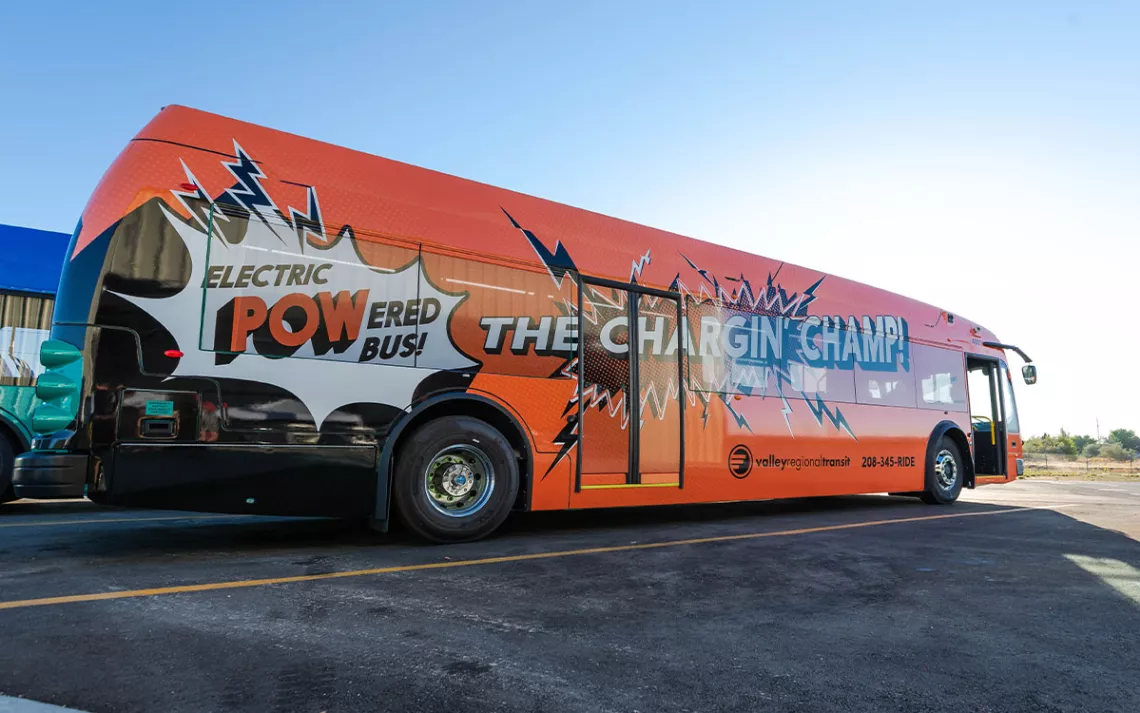The Superhero Buses of Boise
In a city designed for cars and a state run by public transportation skeptics, electric buses found a way to stand out

Photo courtesy Valley Regional Transit
A new team of superheroes have taken over the cozy streets of Boise, Idaho. They’re led by the Chargin’ Champ, outfitted in a glowing orange. Others are the purple Pollution Solution, the deep-blue Silent Rider, and the Clean Green Machine in environmentalists’ classic shade. Every day, this league of electric buses take on the “congestion army,” but the evil forces of smog are no match for the fleet’s “voltray,” the super benefits of bus riding: clean air, less traffic, cheaper transportation, and reduced greenhouse gases. Boise’s buses may be the only public transit in the country to have their own comic book.
The double-axle, 15-ton machines are the flashy start to an ambitious initiative to expand mass transit in a ballooning city and politically conservative state. Valley Regional Transit, which serves 800,000 people in Treasure Valley, where Boise sits, is up against some of the steepest odds in public transportation. For starters, transit in Idaho has no taxing authority, which makes it reliant on contributions from other agencies. Federal funding only comes if local agencies can match it, and the transit office’s own initiatives can cover just a sliver of the cost. The department recently said it would need to restructure its routes as fuel costs and wages squeeze operating expenses.
Valley Regional Transit is the only agency that consistently needs to scrounge for its funding. At least as far as CEO Elaine Clegg has found, it’s the only public transit authority in the country that has neither state nor local guaranteed funding. According to VRT data, Boise has access to between half and a tenth the funding per capita that other city transit offices have. Clegg, who became head of the VRT this year after decades of work in nonprofits and as city council president, says that finding stable funding for mass transit has been the central question of her career. “As a state, we’ve never answered that question,” she said. “We’ve kicked the can down the road.”
State legislators—who in Idaho are 83 percent Republican—are not helping. Earlier this year, they passed a law that restricts the use of property taxes for transportation to road construction. Another new law excludes transit from its definition of “congestion mitigation.” Lawmakers told the Idaho Statesman that the intention was not to impair public transit, but it further complicates VRT’s finances.
Despite such formidable challenges, Clegg and the transit office have set their sights on not only electrifying transit but also expanding service in a city known for sprawl. Supported by federal grants, VRT is slowly swapping out its 54-strong diesel fleet for battery-powered buses. It has 12 so far (albeit only four superheroes). The Federal Transit Administration covers the premium of an electric bus, which can be half as much as the cost of a compressed-gas-powered model.
The superhero paint jobs were themselves a strategic bet, an alternative to the full-bus advertising wraps that a few companies had already expressed interest in. VRT chose otherwise. Getting people to ride transit was the most important goal, said chief development officer Stephen Hunt. Super smog-fighting buses could capture attention.
Public transit across the country is struggling to match the demand for service. Public opinion surveys show US citizens in general support of more-robust public transit options, but opinion on paying for it with taxpayer funds is more divided. A survey last year commissioned by VRT suggested that half of respondents “would never” ride the bus, yet 80 percent said public transportation “is something this area needs.” People didn’t use public transportation because of the weak transportation system. It’s a chicken-or-egg situation: People won’t use it unless it’s expanded, but it’s difficult to get funding to expand when so few people use it.
Electric transit also brings unique difficulties. Residents have expressed concern about the fate of spent batteries, so VRT chose to only lease them from the manufacturer, Proterra. Electric buses and charging sites require more capital expenditures upfront, but they cost less to maintain and are predicted to last longer. VRT’s development of electricity infrastructure in the city also has the potential to smooth the transition to electrifying buildings and homes in the city.
In June, the Boise City Council approved rules to encourage higher-density development. With stores, jobs, and residents closer together, VRT hopes, transit networks can better support residents. “What I'm interested in,” said Hunt, “is reducing barriers to people's freedom and making it easier for somebody to get from where they are to where they need to be.”
 The Magazine of The Sierra Club
The Magazine of The Sierra Club



